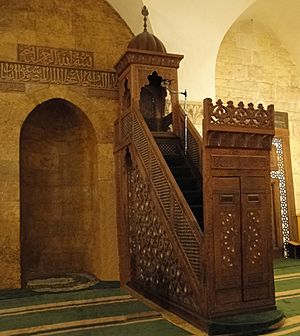Mihrab facts for kids
A Mihrab (pronounced MEE-rahb) is a special part of a mosque, which is a place of worship for Muslims. It's like a small, decorated alcove or recess built into one of the mosque's walls. This special niche helps people know which way to face when they pray.
Muslims pray facing towards the Kaaba, a very important building in the city of Mecca in Saudi Arabia. The Mihrab always points in this direction, which is called the qibla. So, the wall where the Mihrab is found is known as the "qibla wall."
Contents
What is a Mihrab?
A Mihrab is a curved space, like a small cave, built into the wall of a mosque. It is usually decorated with beautiful patterns, calligraphy (fancy writing), and colorful tiles. The designs often include verses from the Quran, the holy book of Islam.
The main purpose of the Mihrab is to show the direction of prayer. It helps everyone in the mosque know exactly which way to turn during their prayers.
Why is the Mihrab important?
The Mihrab is very important because it marks the qibla (KIB-lah). The qibla is the direction of the Kaaba in Mecca, Saudi Arabia. Muslims all over the world pray facing the Kaaba.
Having a Mihrab in every mosque makes sure that all worshippers are facing the correct direction. This helps create a sense of unity among Muslims during prayer.
Where can you find Mihrabs?
Mihrabs are found in almost every mosque around the world. They can be simple or very grand, depending on the size and age of the mosque. Some of the oldest Mihrabs are hundreds of years old and are amazing examples of Islamic art and architecture.
They are often the most decorated part of the mosque. This shows their importance in guiding prayer and connecting worshippers to Mecca.
Images for kids
-
Mihrab in the Mosque–Cathedral of Córdoba
-
8th-century marble mihrab found in the al-Khassaki Mosque in Baghdad, now housed at the Iraq Museum
-
Mihrab in the Great Mosque of Damascus
-
Mihrab of Kalyan Mosque in Bukhara, Uzbekistan
See also
 In Spanish: Mihrab para niños
In Spanish: Mihrab para niños







